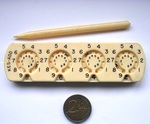
The Kesling Pocket Adder, or The Kes-Add Precision Pocket Adder, is a simple 4-digit counter which was made in the USA from about 1954.
This is the instruction leaflet that comes with the machine.
There are four number wheels which the user can adjust using the stylus provided with the machine. The bottom of each wheel is exposed showing a single digit. Most of the rest of the wheel is covered except for a circular slot through which you can see part of the wheel that has holes for the tip of the stylus. The numbers 1 to 9 are printed around the outside of each slot. To add a number, enter the digits one at a time simply by putting the stylus in the hole next to the digit you want to add and turning the wheel clockwise until the stylus hits the end of the slot. When a wheel is turned from 9 to 0, a carry to the next wheel is performed automatically.
Subtraction is almost the same as addition. Around the inside of the slot the digits 1-9 are printed again in a smaller font and in the opposite order compared to those on the outside. These are used in subtraction. Simply put the stylus next to the digit you want to subtract and move the wheel anticlockwise until the end of the slot. It will automatically borrow from the next higher digit whenever a wheel goes below 0 to become 9.
There is no clearing mechanism. To clear, you have to subtract the value of each digit so that it becomes 0. To help with this, there is an X marked on each wheel and you simply put your stylus to the right of it and move anticlockwise. The X will be hidden just past the end of the slot when a wheel displays zero.
The mechanism is very simple. There are the four visible number wheels, and between them are three gears that provide the carry mechanism. All the number wheels are actually tilted slightly to the left, so that they interact with the carry wheel that lies behind the number wheel to the left. The only other internal moving part is a frame-like piece pulled against the number wheels by a metal spring, and this provides an alignment mechanism. The reason that the alignment is performed by a single piece is not merely for simplicity. Using separate parts with springs for each wheel would make it much harder to perform a carry from 9999 to 10000 as the stylus would have to push back four springs instead of just one.
It was designed by Elmer G. Kesling in the mid 1940s. Mine comes in a plastic sleeve, with an instruction leaflet, though they were also sold in hard plastic cases. The front of the adder has "KES-ADD" printed on it. The rear says "Kesling Pocket Adder, St Louis, Mo." and a patent number. The instruction leaflet says it is distributed exclusively by the Hart Vance Company, St Louis.
Here are some articles about Elmer G. Kesling (1881-1961). He was a dentist and an inventor. Most of the articles are about him winning a court case against General Motors which had used his patented assisted gear shift (US 2,052,573, 1936) in 2 million Chevrolets since 1938.
| Patent | Filing date | Publish date | Name | Description |
|---|---|---|---|---|
| US 2,450,668 | 22-05-1944 | 05-10-1948 | Elmer G. Kesling | Calculator |
| US 2,935,257 | 26-01-1955 | 03-05-1960 | Elmer G. Kesling | Releasable Restraining Device For Rotatable Parts Of Calculators |
© Copyright 2016 Jaap Scherphuis, mechcalc a t jaapsch d o t net.